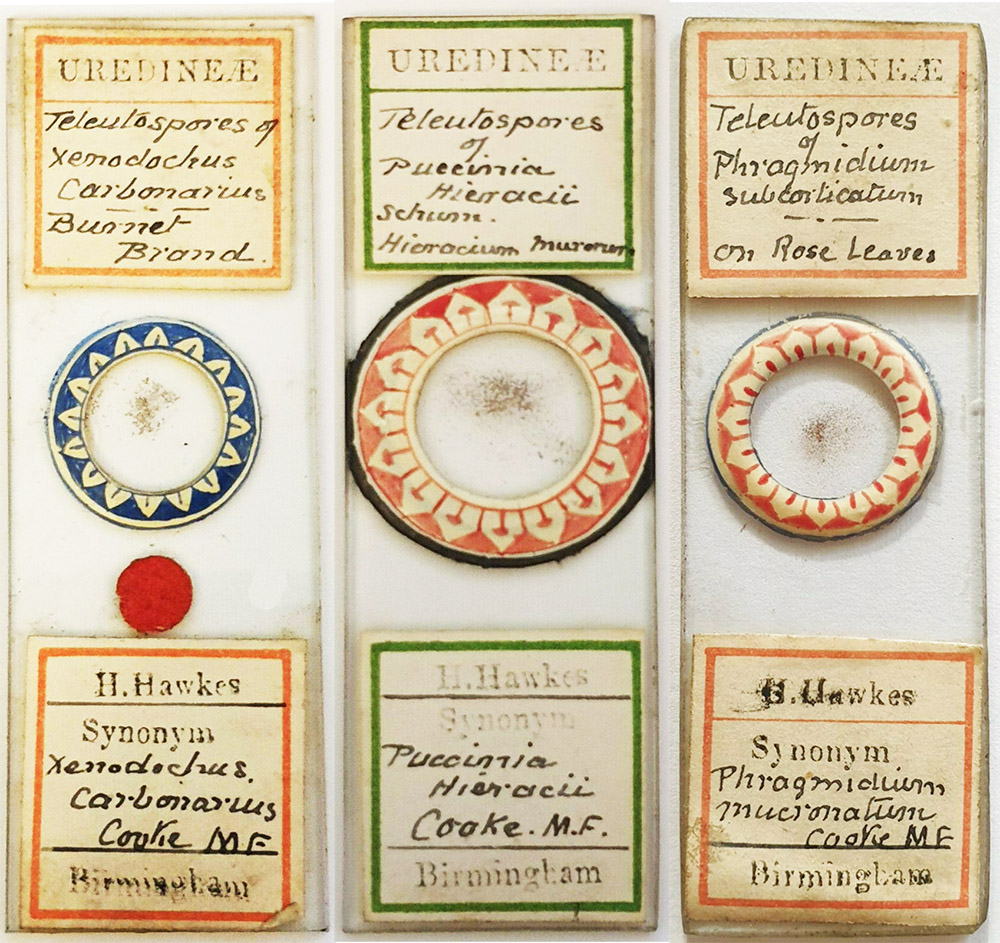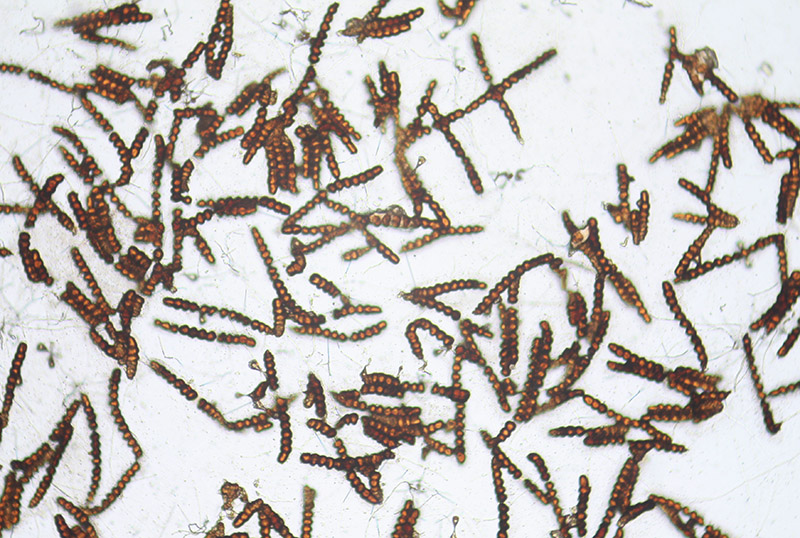Herbert Henry Hawkes, 1842 - 1909
by Brian Stevenson
last updated June, 2021
H. Hawkes, of Birmingham, England, was an avid amateur microscopist during the last quarter of the nineteenth century. He was a long-time member of the Birmingham Microscopists' and Naturalists' Union. Minutes of that society's meetings indicate that Hawkes had a substantial interest in microscopical fungi. Hawkes frequently made presentations to his society, suggesting that he made a considerable number of microscope slides.
Intriguingly, the known mounts by Hawkes are decorated by patterned ringing resembling that of James W. Neville (1840-1900), who was also a member of the Birmingham Microscopists' and Naturalists' Union. This suggests that either Hawkes asked his colleague to decorate a number of slides, Hawkes acquired some slides from Neville and applied his own labels, or Hawkes emulated Neville's artistic style of ringing. I suggest that it is most likely that Neville decorated the illustrated slides for his colleague, possibly to pretty them up for a major exposition.
Hawkes' interest in microscopy was likely associated with his profession as a "brass finisher" of microscopes (that is, he polished and lacquered the brass microscope bodies). He probably worked for J. Parkes & Son or R. Field & Son, who were major instrument makers in Birmingham.

Figure 1.
ca. 1890 microscope slides by Herbert Hawkes. All are of microscopical fungi, which was a particular interest of Hawkes'. As discussed above, the ringing patterns are strikingly similar to the decorations that Hawkes' microscope club colleague, James Neville, painted on his microscope slides, and may have been applied by Neville. Images adapted for nonprofit, educational purposes from an internet auction site.

Figure 2.
Photomicrograph of teleutospores (teliospores) of Xenodochus carbonarius, dry-mounted by Hubert Hawkes (see Figure 1). Ironically, these spores of a fungus that parasitizes plants have, in turn, been attacked by another, mycelium-forming fungus. Photographed with a 10x objective lens and a C-mounted digital SLR camera.
Herbert Hawkes was born on June 2, 1842, in Birmingham. He was the youngest of at least four children of Thomas and Mary Hawkes. Herbert's baptism record and the 1851 census described the father's occupation as "Professor of music". For the 1861 census, father Thomas' occupation was listed as "news agent". Two unmarried sisters then lived with Herbert and the parents: 28 year-old Ellen who was a "pearl button maker", and 21 year-old Fanny who was a "paper box maker". Nineteen year-old Herbert was already working as a "brass founder".
The 1865 parish record of Herbert Hawkes' marriage to Maria Jennings listed his occupation as "optical instrument maker". His name has not been found in any business directory or list of instrument making businesses, implying that Hawkes worked as an employee. His 1865 home on Alma Street was about 1 mile (1.6 km) from the J. Parkes & Son factory on Saint Mary's Row, and about 2 miles (3.2 km) from that of R. Field & Son on New Street. After their marriage, Herbert and Maria moved to 71 Great King Street, then to 300 Bridge Street West, both of which were slightly closer to both of those optical instrument factories.
The 1871 census listed Herbert's occupation as "tin plate worker and tool maker", suggesting that he may have then worked for someone other than a scientific instrument maker. However, Parkes began as a manufacturer of stamped metal items, and were later noted for their machine rolled and cut drafting tools, so it is possible that Hawkes made such items. The 1881 census listed his as "philosophical instrument maker", the 1891 census as "brass finisher, optical work", and the 1901 census as "brass worker, photographic". Toward the end of the nineteenth century, general interest in microscopy waned, while enthusiasm for photography grew, and most optical instrument manufacturers focused substantial effort toward developing and producing camera lenses and bodies.
The earliest record yet to be located on Herbert Hawkes' interest in biology are minutes of 1883 meetings of the Birmingham Microscopists' and Naturalists' Union, where he exhibited non-microscopic items such as a bivalve mollusk, "district plants", and a "cardinal beetle and larva of Dytiscus".
He soon developed expertise in microscopy and microfungi. On December 1, 1884, "Mr. Hawkes exhibited the following fungi: Lecythea euphorbia, Coleozporium senecionis, Puccinia variabilis, Puccinia lyclinidearum, and Puccinia sonchi, the latter pronounced by Mr. W.B. Grove a species new to Great Britain. Mr. Hawkes also showed the paraphyses of this fungus under the microscope", to the Birmingham Microscopists' and Naturalists' Union. On August 9, 1886, "Mr. H. Hawkes exhibited the following fungi: Trichobasis fube, Xenodochus carbonarius, Sphærotheca castagnei and Erysiphe communis. … The exhibition of microscopical slides was continued, Mr. Hawkes showing a series of preparations of microfungi, notably one containing fourteen species on & slide, from simple Uredo spores to the complex Burnet brand".
Hawkes presented similar items at meetings throughout the rest of the nineteenth century. Notably, James Neville also exhibited items at the majority of those meetings. Thus, Neville and Hawkes would have known each other very well. Neville was a professional artist whose work included painting decorations onto furniture, and it was a small step for him to likewise decorate his microscope slides. On the other hand, Hawkes had no known training in painting or graphic arts. As noted above, I consider it most likely that Neville decorated the slides shown in Figure 1.
Hawkes grew to be considered an authority in microscopical fungi. He evidently shared specimens and knowledge with other investigators. For example, W.B. Grove's 1886 "Fungus-hunting in spring" included this note, "I shall mention none but those which I have seen myself; a few of them have been gathered and sent to me by Mr. H. Hawkes and Mr. W. H. Wilkinson".
In 1889, a report of the Birmingham Microscopists' and Naturalists' Union stated that "Mr. H. Hawkes presented to the Society a collection of two dozen microscopic slides of the Myxomycetes; & hearty vote of thanks was accorded the donor for his gift".
Hawkes' interests extended to other branches of botany, and he often exhibited specimens of plants and seaweeds to his colleagues. Most of those appear to have been large specimens, such as "Mr. H. Hawkes exhibited an album of mounted seaweeds" (March 4, 1889), and "Mr. Hawkes, mounted specimens of Habenaria bifolia, Ruscus aculentus, Botrychium lunaria, and other plants" (March 11, 1889). He also produced a number of slides of botanical objects, such as "Mr. H. Hawkes, preparation of Lomentaria kaliformis and Codium tomentosum, both marine algae" (March 4, 1889), and "Mr. Hawkes, leaves of Drosera rotundifolia, with captive insects", (March 11, 1889). Microscopic and macroscopic specimens were utilized in Hawkes' September 28, 1891 presentation of "a large collection of fungi from Sutton Park, with remarks on their edible and non-edible qualities, and a series of white moulds shown under the microscope, their structure being illustrated by that of Erysiphe communis".
On March 11, 1889, "Mr. H. Hawkes read a paper on 'The Pleasures of an Herbarium'. What is the use of an herbarium? is a question often asked by those who see little to admire in the faded mummies of the beautiful flowers they represent. The pleasures of an herbarium are those of association. The yellow-horned poppy called to mind the boiling sea near which it was gathered ; the orchis reminded us of the treacherous sphagnum in the marsh where it was secured, and so with all other plants. The writer said this was only considering it from a sentimental point of view, and the question remained, of what use is an herbarium? If we once gathered the plants ourselves, we became acquainted with their habitats, and gained a practical knowledge of botany we could not get by any amount of reading. To make our collection as complete as possible we are led into all sorts of places; to inquire into the introduction of plants and their distribution. It also leads us into many a bye-path of science, and brings us face to face with the world of microscopic fungi, the spiders that spin their webs on plants, and the insects and mites that make their cradles in the leaves. This subject opens up so wide a field that it might profitably employ the leisure hours of a life-time".
An 1889 exchange offer in Hardwicke's Science-Gossip exemplifies Hawkes' botanical interests (Figure 3).
During 1897, Hawkes gave two major talks to the Birmingham Microscopists' and Naturalists' Union: "Gatherings from the seashore" and "Popular fungi".
Herbert and Maria Hawkes had three children, all boys. The first died at 2 years old, and the second son died before his 26th birthday. The third son, Walter, was "totally blind from birth", yet lived to marry and be a professional piano teacher and tuner. Herbert Hawkes died during early 1909, when 67 years old.

Figure 3.
An 1889 exchange offer from H. Hawkes, which appeared in "Hardwicke's Science-Gossip".
Resources
Cooke, Mordecai C. (1870) Rust, Smut, Mildew, & Mould: An Introduction to the Study of Microscopic Fungi, Hardwicke, London
England census and other records, accessed through ancestry.com
Grove, W.B. (1886) Fungus hunting in spring, The Midland Naturalist, Vol. 9, pages 164-167
Hardwicke's Science-Gossip (1889) Exchange offer from H. Hawkes, Vol. 25, page 120
Kelly's Directory of Birmingham (1908) "Hawkes Arthur, teacher of pianoforte, 300 Bridge st. west", page 627
Marriage record of Herbert Henry Hawkes and Maria Jennings (1865) Parish records of St. Stephen's, Birmingham, accessed through ancestry.com
The Midland Naturalist (1883) Birmingham Microscopists' and Naturalists' Union, Vol. 6, page 192
The Midland Naturalist (1884) Birmingham Microscopists' and Naturalists' Union, Vol. 8, pages 30-31
The Midland Naturalist (1886) Birmingham Microscopists' and Naturalists' Union, Vol. 9, pages 283-284
The Midland Naturalist (1889) Birmingham Microscopists' and Naturalists' Union, Vol. 12, page 96
The Midland Naturalist (1891) Birmingham Microscopists' and Naturalists' Union, Vol. 14, page 263
Scientific and Learned Societies of Great Britain (1897) Birmingham Microscopists' and Naturalists' Union, page 115


